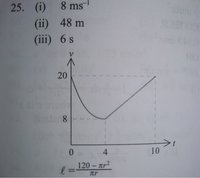Hello all, i am having some trouble finding the right way to solve the following question 25(ii). I assumed that i had to use finite integration as acceleration is not constant for the first part of the question but am not getting the right answer for distance AB.
i tried integrating the equation of Change of velocity but am getting a different answer compared to the book :32
Can someone please help me out?
Question:

Expected answer:

Workings:

i tried integrating the equation of Change of velocity but am getting a different answer compared to the book :32
Can someone please help me out?
Question:

Expected answer:

Workings:

